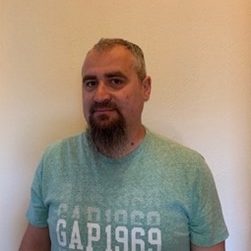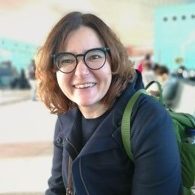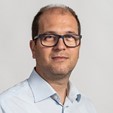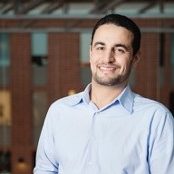IEEE WoWMoM 2021 Panel
Edge is the new cloud: vision and perspectives from industry and academia

On Wednesday June 9th, 2021, at 2pm CEST the 22nd IEEE International Symposium on a World of Wireless, Mobile and Multimedia Networks (WoWMoM) has hosted a panel on “Edge is the new cloud: vision and perspectives from industry and academia” moderated by the coordinator of the MARVEL project Prof. Sotiris Ioannidis. The conference was sponsored by the IEEE Computer Society and the Missouri University of Science & Technology in USA, and organized by the Institute of Informatics and Telematics (IIT) of the National Research Council (CNR) in Italy. Four distinguished panelists have shared their views and opinion on the hottest challenges of edge computing.

Prof. Yingying Chen
Peter D. Cherasia Faculty Scholar. ECE professor at Rutgers University, New Jersey, United States, leading the Data Analysis and Information Security Laboratory (DAISY).
Panel highlights relevant to MARVEL
Edge computing is one of the key pillar technologies of MARVEL, which aims at achieving multi-modal real-time data analytics for smart city applications in the edge-fog-cloud continuum. The panel has started with an initial position presentation given by the panelists. Some highlights that are relevant to the MARVEL scope and scenarios follow.
- It has been foreseen that data and processing management at the edge will become increasingly autonomic, i.e., it will be able to self-organise and self-optimise through a series of advancements in the areas of swarm intelligence and other biology-inspired optimization techniques.
- From the point of view of adoption in the telecom industry, the role of open source has been identified as pivotal. This is well accepted for cloud technologies, but rather unprecedented in the sector of telecommunications, which traditionally relies of closed technologies. However, this is changing and standardisation bodies, such as ETSI and 3GPP, have recently started embracing open source software by referencing explicitly projects of the Cloud Native Foundation and others. In the specific context on edge computing, there is an ongoing collaboration between ETSI ISG MEC and the Akraino project of the Linux Foundation.
- Finally, it is noted that edge computing is key to unlocking most of the beyond-5G use cases (e.g., holographic teleportation, augment projection surfaces, situational awareness – analytics, Internet of Everything, Internet of Intelligence, Digital Twin) in addition to the 5G use cases that are not yet fully mature (e.g., autonomous driving, UAV services, Tactile Internet, eHealth, Industry 4.0). The reason is that most of these use cases require to have very low, and possibly deterministic, latency requirements, which cannot be attained with cloud (or even fog) computing.
Questions from the moderator to the panelists
How has edge computing changed in the past 5 years? What’s next for edge computing (5 to 10 years?). Which sector will edge computing impact the most?
 Ana Juan Ferrer: In the future, we need to push more on Artificial Intelligence at the edge, which can be a real game changer. For Atos, two of the sectors that will be most affected in the near term are (smart) manufacturing and telco (i.e., MEC).
Ana Juan Ferrer: In the future, we need to push more on Artificial Intelligence at the edge, which can be a real game changer. For Atos, two of the sectors that will be most affected in the near term are (smart) manufacturing and telco (i.e., MEC).
Dario Sabella: The ETSI ISG MEC has changed its name from Mobile Edge Computing to Multi-access Edge Computing to convey the message that a broader scope should be sought by the industry group, i.e., from telco operator only to a large ecosystem of stakeholders. The group is working very hard on the multi-cloud/multi-edge federation, which can take the adoption of edge computing to its next level.
Yingying Chen: Edge computing was initially perceived as a peripheral of cloud computing in data centres made of small devices, with limited compute power. Nowadays, the edge has been incorporating more powerful devices, so the challenge for the future is how to run efficiently cloud-native services on edge nodes, while also meeting sustainability targets. There is a need to engage with the end users in the industry to bring a significant impact on technology and our daily life. Furthermore, in the future, we will have to look to mobility aspects, due to the low latency provided by newer technology and 5G integration. The sector that will benefit most from edge computing will be health, for smart and mobile and personalized healthcare, due to the privacy protection offered by processing data at the edge.
Tarik Taleb: The achievements of the past 5-10 years have been: we have established a common understanding of edge/cloud concepts not only in the research community but also in the telecom industry; furthermore, we have understood the potential that open source communities can bring to technology. The next community to engage for the future is that of Artificial Intelligence, for instance for zero-touch management. It is impossible for anyone to divine the use case that will drive full-scale adoption of edge computing, like it has proved impossible in the past to pinpoint the killer application of the next communication technology. However, we can be sure that the business model will change: for instance, we can envision that the connectivity will be cheap (or even free) while customers will pay only for the processing at an edge/cloud level.
What are the most critical changes that we must make to face the future effectively?
Ana Juan Ferrer: The most important change is about ethics: there has been a lot of political push about this, and many individuals are way more concerned about their privacy and ethics than before.
Dario Sabella: Standardisation bodies have to change their mindset regarding the collaboration with open source. ETSI MEC is working with GSMA, 3GPP, but also with open source communities because the stakeholders need that. One risk ahead is that there are now too many standardization bodies in the area of edge computing, which can lead to large overlaps in the scope and possibly hampering the interoperability, which could become a roadblock for the market.
Yingying Chen: Data collection is most critical, together with data exposure and transfer between edge and cloud, as well as long-term storage, not only for performance reasons (high bandwidth needed) but even more so for privacy issues.
Tarik Taleb: We need to involve social sciences into the design of future edge-cloud systems: we are becoming increasingly dependent on technology, so there are huge risks associated to the transformation of society. An example is the issue of liability for safety-related systems: who is to take the blame for an accident involving autonomous driving cars?
Urban networks are collecting a variety of data including highly sensitive citizen data which are vulnerable to many security threats. Data privacy and ethics compliance is a serious challenge for any smart city when sharing and/or when processing such multimodal data. Privacy, trust and data confidentiality come at a price. How can we balance public safety while ensuring citizen privacy? How can we overcome the fears and suspicions of citizens?
Ana Juan Ferrer: We need to keep the control. Today citizens are now completely aware of what happens to their data, mostly because there is a low exposure to technology. This needs to change: more transparency will lead to a better understanding, which in turn will increase the acceptance of new technologies.
Dario Sabella: Local processing at the edge inherently helps privacy. Standardisation can be key to enable trust in the upcoming services based on edge computing.
Yingying Chen: Unfortunately, security is a never-ending fight. In real life, a good citizen behaves well in their physical interactions: this should be extended to the digital interactions. Social scientists will have a pivotal role in understanding how to achieve this goal, even though this will raise even more inter-disciplinary research challenges.
Tarik Taleb: The role of government is crucial: they have to help with proper legislation and to appoint auditors who will look into privacy violations and punish companies not complying with severe fines or other measures.
Questions from the audience to the panelists
What is the role of quantum computing in the edge ecosystem?
Ana Juan Ferrer: Atos considers quantum computing as an integral part of the edge-cloud continuum of the future, and it already uses quantum computing technology within its High Performance Computing infrastructure
Dario Sabella: Quantum technologies are progressing faster than expected, but they are still in a very early phase, thus out of the radar of standardization bodies, expect for very specific applications like Quantum Key Distribution. In the future, standardization bodies will have to monitor progress and react accordingly.
Yingying Chen: Traditionally, hardware comes first, then comes the software. For edge computing, we need to co-design hardware and software if we want the overall services to run efficiently, e.g., with deep-learning optimisations. The same applies to quantum and edge computing.
Tarik Taleb: Quantum computing may break current security algorithms and protocols, therefore we need to re-think security aspects of edge, cloud, and communication systems to make them quantum-proof.
What would you ask the panelists if you had the chance? What is your view on the topics discussed? Hereby a few useful links regarding the panel discussion and the whole event:
YouTube channel: IEEE WoWMoM
Twitter account: WoWMoM2021
Feel free to reach out using the MARVEL contact form for any comments or questions related to the above. You can also find us on Twitter and LinkedIn.
Signed by: the CNR team and the co-organizer of the event Claudio Cicconetti
Menu
- Home
- About
- Experimentation
- Knowledge Hub
- ContactResults
- News & Events
- Contact
Funding

This project has received funding from the European Union’s Horizon 2020 Research and Innovation program under grant agreement No 957337. The website reflects only the view of the author(s) and the Commission is not responsible for any use that may be made of the information it contains.





